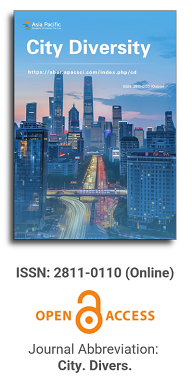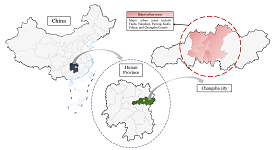
Asia Pacific Academy of Science Pte. Ltd. (APACSCI) specializes in international journal publishing. APACSCI adopts the open access publishing model and provides an important communication bridge for academic groups whose interest fields include engineering, technology, medicine, computer, mathematics, agriculture and forestry, and environment.

As China's pillar industry, the property market has suffered a considerable impact in recent years, with a decline in turnover and many developers at risk of bankruptcy. As one of the most concerned factors for stakeholders, housing prices need to be predicted more objectively and accurately to minimize decision-making errors by developers and consumers. Many prediction models in recent years have been unfriendly to consumers due to technical difficulties, high data demand, and varying factors affecting house prices in different regions. A uniform model across the country cannot capture local differences accurately, so this study compares and analyses the fitting effects of multiple machine learning models using February 2024 new building data in Changsha as an example, aiming to provide consumers with a simple and practical reference for prediction methods. The modeling exploration applies several regression techniques based on machine learning algorithms, such as Stepwise regression, Robust regression, Lasso regression, Ridge regression, Ordinary Least Squares (OLS) regression, Extreme Gradient Boosted regression (XGBoost), and Random Forest (RF) regression. These algorithms are used to construct forecasting models, and the best-performing model is selected by conducting a comparative analysis of the forecasting errors obtained between these models. The research found that machine learning is a practical approach to property price prediction, with least squares regression and Lasso regression providing relatively more convincing results.
Cultural diversity and enterprise innovation: A study from the perspective of dialect
Vol 5, Issue 1, 2024
Download PDF
Abstract
China has a vast territory. The rich and different regional culture formed over the past 5000 years is an ideal scene for the study of "culture and finance". This paper uses the number of urban dialects and dialect differentiation index to measure regional cultural diversity, and empirically studies its impact on enterprise innovation. The results show that in areas with more diverse cultures, private high-tech enterprises will obtain more innovative output. After using instrumental variables to solve endogenous problems and excluding the impact of educational development, the conclusion of this paper is still robust. Further research also found that the greater the difference between different dialects in the city where the company is located, the greater the population inflow, the better the inclusiveness and the higher the level of intellectual property protection, the more significant the impact of dialect diversity on innovation. The conclusion of this paper will help the academic community to understand the non institutional reasons behind the unbalanced economic development of Chinese cities from a new perspective, and also provide empirical evidence from non immigrant countries with deep cultural heritage for the current international academic research on "culture and finance".
Keywords
References
- Qian H. Diversity Versus Tolerance: The Social Drivers of Innovation and Entrepreneurship in US Cities. Urban Studies. 2013; 50(13): 2718-2735. doi: 10.1177/0042098013477703
- DiMaggio P. Culture and Cognition. Annual Review of Sociology. 1997; 23(1): 263-287. doi: 10.1146/annurev.soc.23.1.263
- Ottaviano GIP, Peri G. The economic value of cultural diversity: evidence from US cities. Journal of Economic Geography. 2005; 6(1): 9-44. doi: 10.1093/jeg/lbi002
- Simonen J, McCann P. Firm innovation: The influence of R&D cooperation and the geography of human capital inputs. Journal of Urban Economics. 2008; 64(1): 146-154. doi: 10.1016/j.jue.2007.10.002
- Page S. The Difference: How the Power of Diversity Creates Better Groups, Firms, Schools, and Societies. Princeton University Press; 2008.
- Florida R. Therise of the Creative Class. Washington Monthly. 2002; 35(5): 593-596.
- Qian H, Stough RR. The effect of social diversity on regional innovation: measures and empirical evidence. International Journal of Foresight and Innovation Policy. 2011; 7(1/2/3): 142. doi: 10.1504/ijfip.2011.040071
- Talhelm T, Zhang X, Oishi S, et al. Large-Scale Psychological Differences Within China Explained by Rice Versus Wheat Agriculture. Science. 2014; 344(6184): 603-608. doi: 10.1126/science.1246850
- Ruan J, Xie Z, Zhang X. Does rice farming shape individualism and innovation? Food Policy. 2015; 56: 51-58. doi: 10.1016/j.foodpol.2015.07.010
- Ozgen C, Nijkamp P, Poot J. Immigration and Innovation in European Regions. SSRN Electronic Journal. 2011. doi: 10.2139/ssrn.1835315
- Nathan M. Same difference? Minority ethnic inventors, diversity and innovation in the UK. Journal of Economic Geography. 2014; 15(1): 129-168. doi: 10.1093/jeg/lbu006
- Li X, liu Y. A new probe into the relationship between language, thinking and culture from the perspective of linguistic typology. Journal of Northeast Normal University (PHILOSOPHY AND SOCIAL SCIENCES EDITION). 2014; 4: 148-152.
- Chen MK. The Effect of Language on Economic Behavior: Evidence from Savings Rates, Health Behaviors, and Retirement Assets. American Economic Review. 2013; 103(2): 690-731. doi: 10.1257/aer.103.2.690
- Xu X, liu Y, Xiao Z. Dialects and economic growth. Journal of economics. 2015; 2: 1-32.
- Jia J, Lun X, Lin S. Financial development, micro enterprise innovation output and economic growth—An Empirical Analysis Based on the perspective of patents of listed companies. Financial research. 2017; 1: 99-113.
- Cai J, Dong Y. Banking competition and enterprise innovation—Empirical Evidence from Chinese industrial enterprises. Financial research. 2016; 11: 96-111.
- Peri G. Determinants of Knowledge Flows and Their Effect on Innovation. Review of Economics and Statistics. 2005; 87(2): 308-322. doi: 10.1162/0034653053970258
- Adhikari BK, Agrawal A. Religion, gambling attitudes and corporate innovation. Journal of Corporate Finance. 2016; 37: 229-248. doi: 10.1016/j.jcorpfin.2015.12.017
- Feng Z, Tang Y, Yang Y, et al. Topographic relief and its correlation with population distribution in China. Journal of geography. 2007; 10: 1073-1082.
- Liu Y, Xu X, Xiao Z. Inverted U-shaped model of cross dialect labor flow. Economic research. 2015; 10: 134-146.
- Mellander C, Florida R. Creativity, talent, and regional wages in Sweden. The Annals of Regional Science. 2009; 46(3): 637-660. doi: 10.1007/s00168-009-0354-z
- Pan Y, pan J, Dai Y. Corporate litigation risk, judicial local protectionism and enterprise innovation. Economic research. 2015; 3: 131-145.
- Pan Y, pan J, Dai Y. Patent infringement litigation and enterprise innovation. Financial research. 2016; 8: 191-206.
- Fan G, Wang X, Zhu H. China’s marketization index—2010 annual report on the relative process of marketization in various provinces and regions. Beijing: Economic Science Press; 2011.
Supporting Agencies
Copyright (c) 2024 Yue Pan, Jinli Xiao, Yiyi Dai

This work is licensed under a Creative Commons Attribution 4.0 International License.

This site is licensed under a Creative Commons Attribution 4.0 International License (CC BY 4.0).

Prof. Mehmet Cetin
Kastamonu University,
Turkey
Polish Scientific Bibliography

